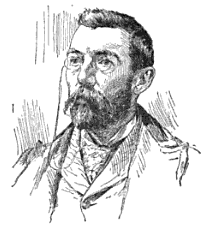Frank Ver Beck

He was born in Richland Township, Belmont County, Ohio as the son of a shoemaker.[1] He studied art and woodcarving under Mansfield, Ohio artist Robert R. "Railroad" Smith and worked as a wood engraver.[1]
In 1881 or 1882, Ver Beck moved to New York City. There he studied art and became a freelance illustrator for magazines including Scribner's, Ladies' Home Journal, and Collier's.[1]
In 1894 in Munsey's Magazine, Harold Payne wrote:For quaintness of conceit and weirdness of treatment William Francis Ver Beck has no parallel. His specialty is in making animals, and particularly reptiles, to represent human beings in comical situations. He invests crocodiles, turtles, lizards, frogs, and other amphibiae with human attributes, places them in all sorts of ludicrous positions, and carries them through endless laughable experiences. He even descends to the vegetable kingdom for his subjects, and invests cabbages, carrots, and beets with the power of lingual communication. Indeed, Ver Beck might well be designated as the artistic Aesop of the time.[3]
Ver Beck was one of author Stephen Crane's first friends in New York City.[4] One winter evening Crane and British artist Phil May borrowed a tiger skin belonging to Ver Beck and were arrested walking huddled under the skin on Broadway in the early morning hours. They were released but the policeman kept the tiger skin.[5] Also in New York City, in 1895 Ver Beck witnessed the shooting of Solomon Mann by David Hannigan and testified in Hannigan's trial.[6]
Shortly before World War I, he moved to England.[1] In 1913, he was working in St Ives, Cornwall with his wife, the American-born artist and author Hanna Rion.(1875—1924) Their relationship ended and she remarried in 1921.[7] He died at the age of 75 in Essex.[1]
Bibliography

- The Dumpies and the Arkansas Bear by Albert Bigelow Paine (1896)
- The Magical Monarch of Mo by L. Frank Baum (1898)
- The Three Bears (1899)
- Acrobatic Animals (1899)
- Beasts and Birds (1900)
- Handbook of Golf for Bears (1900)
- Beck's Book of Bears (1906)
- Short Little Tales from Bruintown (1915)
- Ver Beck's Bears in Mother Gooseland (1915)
- The Little Lost Bear (1915)
- Timothy Tuttle's Great Day (1917)
- The Donkey Child (1918)
- The Elephant Child (1920)
- The Little Cat Who Journeyed to St. Ives (1921)
- The Little Lost Lamb (1922)
- The Little Bear Who Ran Away From Bruintown (1923)
- Little Black Sambo and the Baby Elephant (1925)
- Little Black Sambo and the Monkey People (1929)
- The Arkansas Bear Complete by Albert Bigelow Paine (1929)
References
- ↑ 1.0 1.1 1.2 1.3 1.4 1.5 Mary Sayre Haverstock; Jeannette Mahoney Vance; Brian L. Meggitt; Jeffrey Weidman, Oberlin College. Library (2000). Artists in Ohio, 1787-1900: a biographical dictionary. Kent State University Press. p. 890. ISBN 978-0-87338-616-6. Retrieved 31 August 2011.
- ↑ "W. Francis Ver Beck, Illustrator, Dies: Author of Books for Children for Which He Provided Drawings - Collaborated With Paine.". New York Times. August 1, 1933. p. 17.
- ↑ Harold Payne (1894). "Our Caricaturists and Cartoonists". Munsey's Magazine 10. The Frank A. Munsey company. p. 549. Retrieved 1 September 2011.
- ↑ Stanley Wertheim (1997). A Stephen Crane encyclopedia. Greenwood Publishing Group. p. 350. ISBN 978-0-313-29692-5. Retrieved 1 September 2011.
- ↑ Davis, Linda H. (1998). Badge of Courage: The Life of Stephen Crane. Boston: Houghton Mifflin. pp. 56–57.
- ↑ "IN FAVOR OF HANNIGAN: WITNESSES THINK THAT HE ACTED IN AN IRRATIONAL WAY. AFFECTED BY HIS SISTER'S DEATH EVIDENCE TO SHOW THAT HIS DEMEANOR WAS NOT THE SAME AFTER THE ILLNESS OF LORETTA -- DEFENSE STILL UNFINISHED.". New York Times. November 5, 1895. p. 16. Retrieved August 31, 2011.
- ↑ "William Francis VER BECK". Cornwall Artists Index. West Cornwall Art Archive. Retrieved September 1, 2011.